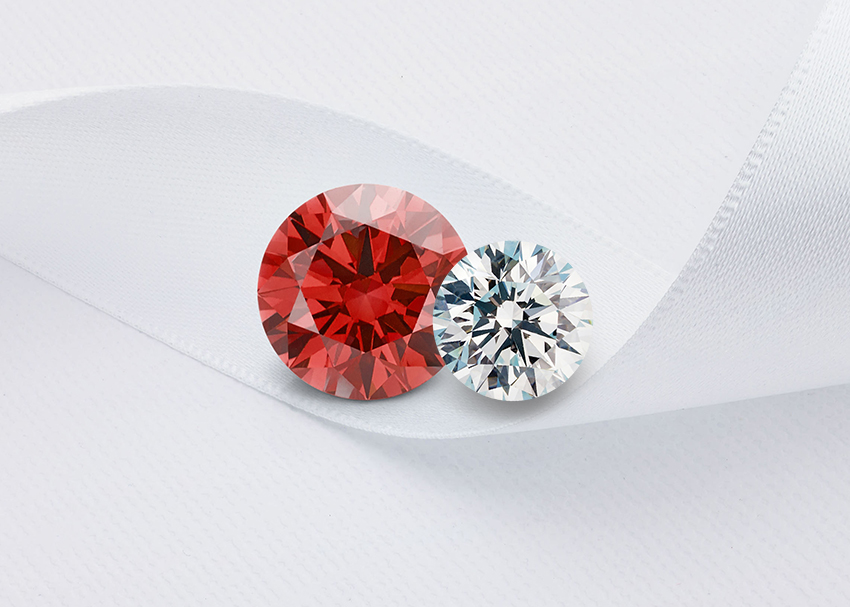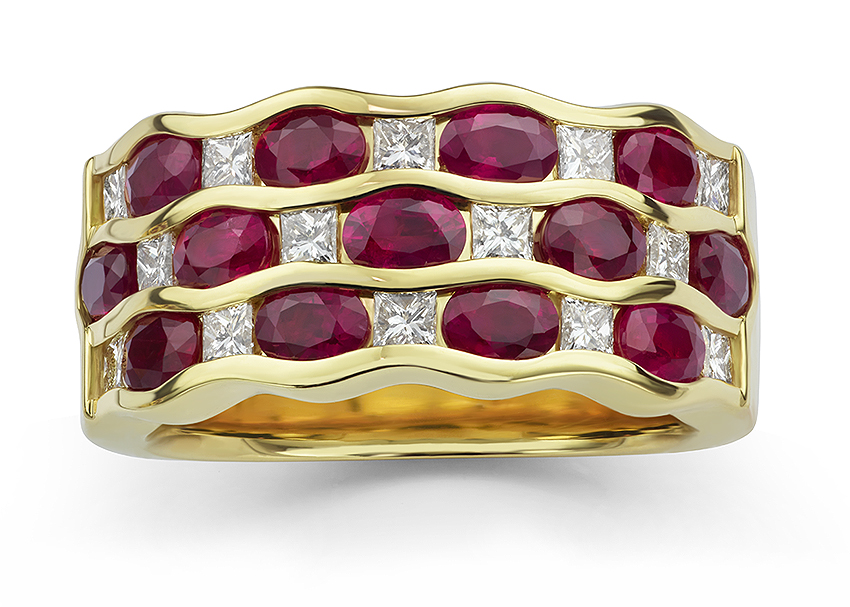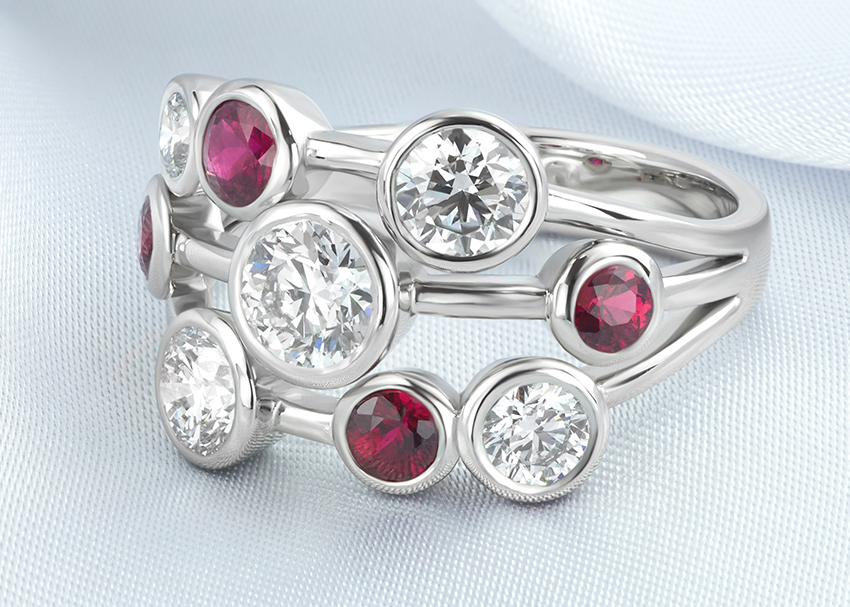Click here to get this article in PDF

A comparison between Ruby vs Diamonds reveals a wide range of differences worthy of attention. For many buyers, both gems provide alternative choices. At the same time, both gemstones appeal to specific buyers—often for specific reasons. For example, diamonds represent the most popular choice for engagement rings by convention. In contrast, rubies make less popular engagement ring gemstones. Instead, they serve significant milestone life events.
A comparison of colour
The most obvious difference between both gemstones comes from their colour. Buyers value rubies for their incredible red colour. This typically varies between a deep red colour and pinkish red. Conversely, we prize most diamonds for their lack of colour. However, contradictions arise when we consider naturally coloured diamonds. In fact, red diamonds stand apart as one of the rarest gemstones in the World.

Ruby vs. diamond: composition
Despite certain similarities, both diamonds and rubies differ in their chemical composition. As many people appreciate, diamonds form from a crystalline form of Carbon, under extremes of high temperature and pressure. By comparison, a ruby’s chemical composition derives from Corundum—a form of Aluminium Oxide.
Special occasions for each gemstone
Both rubies and diamonds serve specific occasions. For example, Ruby represents a 40th wedding anniversary. As such a bespoke ruby ring makes a very special gift for 40 years of marriage. In addition, the ruby represents the birthstone for July.

By comparison, a diamond serves as the birthstone for April. At the same time, a diamond wedding anniversary marks an incredible 60 years of marriage.
Availability and demand
As previously noted, owing to traditional convention, a diamond serves as the most popular gemstone for engagement rings. By comparison, very few couples choose a ruby engagement ring unless the gemstone provides significance. For this reason, the demand for diamonds exceeds the demand for rubies.
Hardness and durability
Both types of gemstones have a similar hardness. However, diamond has a slightly greater hardness at 10 and the Mohs scale. By comparison, rubies have a hardness of 9 on the Mohs scale. Simply put, both gemstone types suit all jewellery types—especially rings—able to withstand daily wear and tear. Most importantly, their hardness ensures the same as-new lustre and sparkle remain in place.
Versatility and colour matching with clothes
Diamond jewellery is extremely versatile. Put simply, the whiteness of a diamond seldom clashes with any colour of clothing. For example, some suggest red and purple rarely work together. But, a white diamond set into Platinum, works with any wardrobe combination. For this reason, Rubies should be considered alongside clothing colours.
Lustre
Lustre refers to the way light interacts with the surface of the gemstone. Different gemstones have varying lustres. For example, we describe the lustre of diamonds as adamantine. This highly reflective lustre of diamonds provides the incredible sparkle associated with this gem.
By comparison, a ruby’s lustre falls between vitreous and subadamantine. Many experts compare a vitreous lustre to the surface of glass. Subadamantine falls somewhere in between. In essence, subadamantine provides a subdued adamantine lustre.
To contrast the colour and lustre of both diamonds and rubies, we suggest a combination of both gemstones as seen in some of our ring commissions. For example two examples below alternate both gemstones.
The difference in cost between rubies and diamonds
From experience, a fine ruby is more expensive than a high-quality diamond. Especially, when you consider examples with the finest colour available for their gemstone type.
We take many factors into consideration when determining value. For example, size. Whereas many large examples of diamonds occur, the rarity of large rubies adds a much higher price compared to diamonds.
At the same time, treatments to enhance colour often influence value. Most coloured gemstones undergo some form of treatment to enhance their colour. However, the treatment of diamonds in a similar way reduces value considerably. Put simply, treatments to improve colour and clarity in diamonds are less desirable than in gemstones.
A summary of comparison
For ease of use, use our table below as a quick reference to compare the different qualities of ruby vs diamond. Other differences exist but the following information provides a clear comparison of the main differences between each gemstone.
| Aspect | Rubies | Diamonds |
|---|---|---|
| Composition | Aluminum oxide with chromium | Carbon |
| Color | Red (range of hues) | Colorless (can be various colors) |
| Hardness | 9 on Mohs scale | 10 on Mohs scale |
| Luster | Vitreous to subadamantine | Adamantine |
| Brilliance | Less brilliant than diamonds | Highly brilliant and sparkly |
| Value and Rarity | Valuable, rarer in larger sizes | Value varies based on various factors |
| Symbolism | Passion, love, power | Eternity, strength, purity |
| Industrial Use | Rarely used industrially | Used for various industrial applications |
| Cultural Significance | Associated with royalty | Gained popularity in modern times |
| Geographical Sources | Myanmar, Thailand, Sri Lanka | Various regions worldwide |
| Cost | High cost, influenced by size | Variable cost based on quality and size |
Get expert help when choosing the perfect ruby (or diamond)
As part of our service, we source most gemstones—not just diamonds. Most importantly, our clients benefit from our careful selection of gemstones for specific designs.
In addition, we provide high-resolution photographs of gems for clients who are unable to visit and inspect gemstones in person. Contact our showroom at any time for help and guidance. We tailor every commission individually to meet requirements for all budgets. Most importantly, we only work with gemstones from ethical sources as part of our responsible sourcing.
The post Ruby vs Diamond: A Buyer’s Comparison of Rubies and Diamonds appeared first on Serendipity Diamonds Blog.
